- Home
- »
- Reports
- »
-
Crude oil Sourcing & Supplier Intelligence Report, 2030
![Crude oil Sourcing & Supplier Intelligence Report, 2030]()
Crude Oil Procurement Intelligence Report, 2023 - 2030 (Revenue Forecast, Supplier Ranking & Matrix, Emerging Technologies, Pricing Models, Cost Structure, Engagement & Operating Model, Competitive Landscape)
- Published Date: Aug, 2023
- Base Year for Estimate: 2022
- Report ID: GVR-P-10530
- Format: Electronic (PDF)
- Historical Data: 2020 - 2021
- Number of Pages: 60
Crude Oil Category Overview
“The crude oil category’s growth is driven by the rising energy demand across the world.”
The crude oil category is expected to grow at a compound annual growth rate (CAGR) of 3.42% from 2023 to 2030. Rising energy demand across the world has driven governments to use modern technologies to seek unexplored oil and gas resources in the upstream sector, which is driving industry growth. Many traditional oilfields' outputs of oil and natural gas are dropping. To address this problem, oil and gas companies are expanding their investments in mature oil and gas areas. The adoption of unconventional exploration and production technology in major shale deposits has expanded upstream oil and gas firms' potential. Growing investment in the upstream oil and gas sector will have a substantial impact on crude oil category growth during the forecast period.
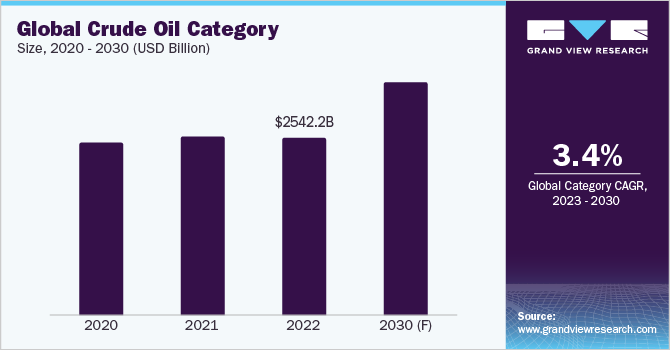
The global crude oil category size was valued at USD 2542.17 billion in 2022. Technological advances in hydraulic fracturing are helping increase the recovery of oil and gas from shale plays. These advances include the use of new drilling technologies, proppant placement, and data acquisition. The integration of IoT, data analytics, and machine learning is also helping to improve the efficiency of hydraulic fracturing. Real-time pressure data is crucial in crude oil production, as it helps to eliminate the over-fracturing issue. Automation of hydraulic fracturing is also optimizing the process and supporting enhanced well performance.
The use of petroleum and crude oil in industries has caused a lot of pollution, which has led to a shift towards cleaner and renewable energy sources. The harmful emissions released from fossil fuels, such as carbon dioxide and carbon monoxide, have negative effects on the environment and human health. These emissions contribute to global warming, ozone layer depletion, and sea level rise. Oil spills, which are common in the extraction of petroleum, can also disrupt marine life. As a result of these negative effects, industries are looking for cleaner alternatives, such as solar and wind energy, and electric vehicles. These factors will disrupt the category growth in the long term.
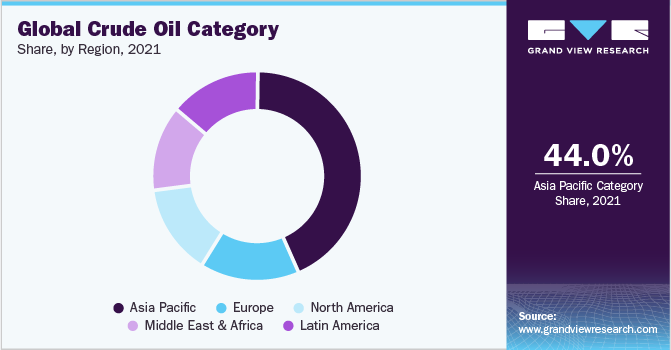
The U.S. administration and the G7 countries debated plans to address rising oil prices, inflation, and Russia's dominance over energy markets in December 2022. At the same time, the International Price Cap Coalition completed the process of putting a price cap on Russian crude oil that was transported by sea. The cap was established at a maximum price of USD 60 per barrel of crude oil. The cap was flexible enough to change in the future in response to changes in the market. The price cap was specially intended to further reduce Russia's revenue while maintaining the stability of the world's energy markets through ongoing supply. Since January 2023, it also aided in reducing inflation and maintaining stable energy prices at a time when high costs, notably higher gasoline prices, were a major concern in the EU and around the world.
As a result of the sanctions put on Russia, Russian oil exports declined by 600 thousand barrels per day (kbpd) in June 2023 to 7.3 million barrels per day (mbpd), the lowest level since March 2021. Estimated export revenues fell by USD 1.5 billion to USD 11.8 billion, or about half of what they were a year ago in 2022. Moscow has guaranteed a further 500 kbpd drop in exports beginning August 2023 to stop the decline in prices and income, but production may remain stable as local oil demand grows seasonally.
Supplier Intelligence
“How can the nature of the crude oil category be best described? Who are some of the key players?”
The crude oil category is consolidated with many large firms deploying various organic and inorganic growth strategies to compete. Several major players are utilizing acquisition techniques to expand their business portfolios and boost their position in the market. Furthermore, partnerships and collaborations are among the most frequent business tactics. Key players in this category are investing in R&D to bring breakthrough technologies and solutions into the category. For instance,
-
In July 2023, Aramco completed a USD 3.4 billion transaction to purchase a 10% stake in Rongsheng Petrochemical Co. Ltd. through its Dutch subsidiary Aramco Overseas Company BV. Under this deal, the company will be able to deliver 480,000 barrels per day of crude oil to Zhejiang Petroleum and Chemical Co. Ltd (ZPC) in a long-term sale agreement.
-
In December 2022, TotalEnergies announced the opening of the Deutsche Ostsee LNG import facility at the port of Lubmin for liquefied natural gas (LNG). TotalEnergies' position as the world's third-largest LNG player and Europe's leading regasification player will be strengthened by this project.
-
In November 2022, Shell Chemical Appalachia LLC, a Shell plc subsidiary, has begun operations at its Shell Polymers Monaca (SPM) location, formerly known as the Pennsylvania Chemical project. This factory produces polyethylene from low-cost ethane derived from shale gas.
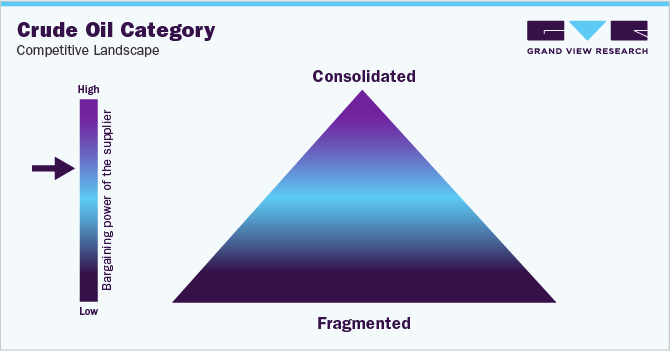
Key suppliers in this category:
-
Saudi Arabian Oil Co.
-
China Petroleum & Chemical Corp.
-
PetroChina Co. Ltd.
-
Exxon Mobil Corp.
-
Shell PLC
-
TotalEnergies SE
-
Chevron Corp.
-
BP PLC
-
Marathon Petroleum Corp.
-
Valero Energy Corp.
Pricing and Cost Intelligence
“What are the total costs associated with crude oil? Which factors impact the price of crude oil?”
The cost of crude oil can be broken down into six major categories: labor, material & equipment, maintenance, infrastructure, transport, taxes & insurance, and other costs. This category is very labor-intensive and requires quality materials and expensive equipment. Thus, labor, material & equipment form the largest cost components of this category. Together, they account for approximately 60% of the total costs. The largest cost component for crude oil is material & equipment, which includes physical components like drill bits, pipes, cement, drilling rigs, pumps, and compressors among others. This category is very labor intensive as it requires skilled labor such as engineers, frackers, pump operators, maintenance workers, and others.
It is important to note that these percentages can vary depending on the specific oil field and the regulatory environment. The cost of labor can be higher in oil fields that are located in remote areas or that have difficult drilling conditions. The cost of materials can also be higher in oil fields that are located in areas with harsh weather conditions. The cost of transportation can also vary depending on the location of the oil field and the distance to the refinery. For example, A typical barrel of oil from Saudi Arabia costs USD 2 to USD 3 to extract from the ground; in contrast, a barrel from Alberta's tar sands might cost upwards of USD 60.
The chart below shows a breakdown of the cost structure associated with crude oil along with major cost components, as demonstrated:
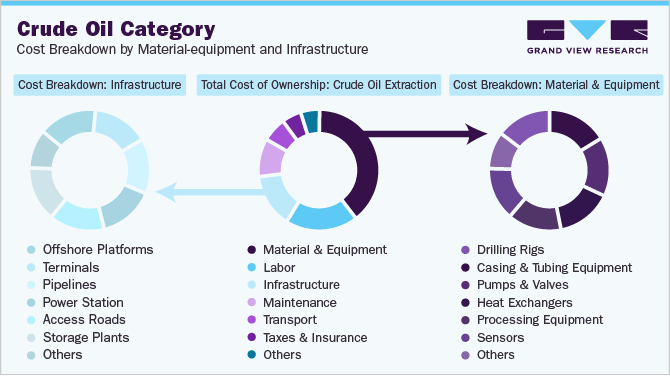
Some of the pricing models deployed in the crude oil category are as follows: Spot price is the most common crude oil pricing model, determined by supply and demand and thus the prices fluctuate wildly based on the market conditions. Under the futures pricing model, the price is the freezing price for delivery at a future date, used for immediate delivery at that time. Cost-plus pricing is based on the cost of producing oil, including labor, materials, equipment, transportation, and royalties. It is typically used for long-term contracts and is adjusted to include a profit margin. OPEC pricing, a cartel of oil-producing countries, controls 40% of the world's oil production and can influence oil prices by adjusting production levels. OPEC meets monthly to discuss production levels and set production quotas for its member countries. For example, Brent crude's price jumped to more than USD 130 per barrel following Russia's invasion of Ukraine. By March 2023, it had, however, retreated to a low of around USD 70 per barrel, a 15-month low.
The Crude Oil Procurement Intelligence Report provides a detailed analysis of the cost structure and the pricing models adopted by prominent suppliers in this category.
Sourcing Intelligence
“Which countries are the leading sourcing destination for Crude Oil? What is the type of engagement model?”
Saudi Arabia, Russia, Canada, Iraq, and the U.S. along with member countries of the OPEC+ group are some of the top sourcing destinations for crude oil. The abundance of oil reserves is the primary reason which makes these countries the preferred location for sourcing crude oil. Saudi Arabia produced $224.8 billion in oil exports in 2022, making it the top oil exporter in the world. In 2022, it was the leading oil producer in OPEC, producing 12.14 million barrels daily, or 12% of the world's total output. In 2022, Canada, the second-largest oil exporter in the world, shipped $120.5 billion worth of oil, or 8.9% of the entire amount exported worldwide. Canada has the fourth-largest oil reserves in the world, with 168 billion barrels, mostly in the oil sands of Alberta. With 62% of all U.S. oil imports coming from Canada and 97% of all Canadian exports going to the United States, the Canadian oil sector is strongly linked to the American economy.
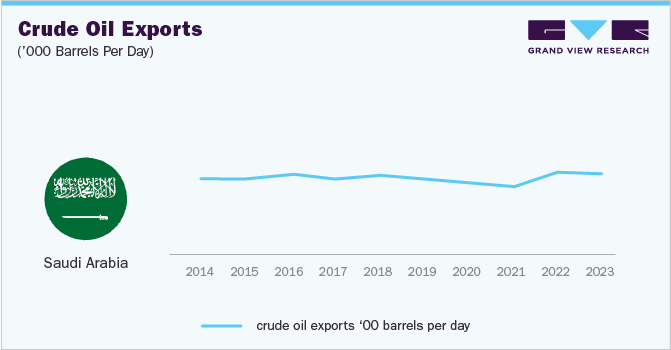
Until 2021, Russia used to be the second-largest exporter of crude oil and other petroleum products. However, in the wake of Russia’s war in Ukraine and the subsequent sanctions imposed on Russia, its share of crude oil export dropped to 8.9% in 2022 compared to 11.8% in 2021.
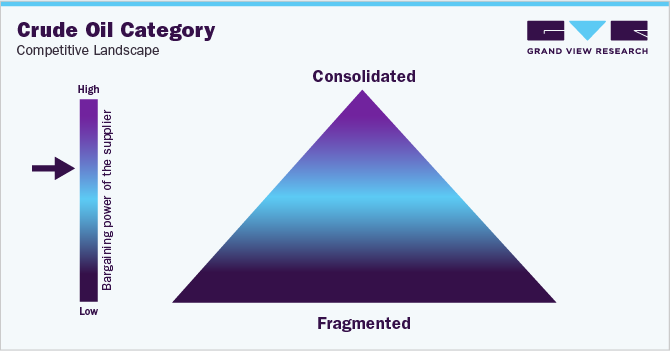
In terms of crude oil sourcing intelligence, Vendors of crude oil typically use a hybrid/bundled outsourcing model. With bundled/hybrid outsourcing, crude oil companies can outsource specific tasks or functions to a third-party provider, while retaining control over other aspects of their operations. For example, a crude oil company might outsource the development and maintenance of its IT infrastructure to a third-party provider, while retaining control over its data security and compliance policies. This would allow the company to focus on its oil and gas operations while ensuring that its IT infrastructure is secure and compliant.
The crude oil Procurement Intelligence report also provides details regarding day one, quick wins, portfolio analysis, key negotiation strategies of key suppliers, and low-cost/best-cost sourcing analysis.
Crude Oil Procurement Intelligence Report Scope
Report Attribute
Details
Crude Oil Category Growth Rate
CAGR of 3.42% from 2023 to 2030
Base Year for Estimation
2022
Pricing Growth Outlook
7% - 13% (annual)
Pricing Models
Spot pricing model, cost-plus pricing model, future price model, OPEC pricing model
Supplier Selection Scope
Cost and pricing, past engagements, productivity, geographical presence
Supplier Selection Criteria
Technology, environmental record, financial stability, service, quality, service, reliability, technical expertise, security measures, cost and value, support and maintenance, regulatory compliance, and others
Report Coverage
Revenue forecast, supplier ranking, supplier positioning matrix, emerging technology, pricing models, cost structure, competitive landscape, growth factors, trends, engagement, and operating model
Key Companies Profiled
Saudi Arabian Oil Co., China Petroleum & Chemical Corp., PetroChina Co. Ltd., Exxon Mobil Corp., Shell PLC, TotalEnergies SE, Chevron Corp., BP PLC, Marathon Petroleum Corp., and Valero Energy Corp.
Regional Scope
Global
Historical Data
2020 - 2021
Revenue Forecast in 2030
USD 3326.9 billion
Quantitative Units
Revenue in USD billion and CAGR from 2023 to 2030
Customization Scope
Up to 48 hours of customization free with every report.
Pricing and Purchase Options
Avail customized purchase options to meet your exact research needs. Explore purchase options
Frequently Asked Questions About This Report
b. The global crude oil category size was valued at approximately USD 2542.17 billion in 2022 and is estimated to witness a CAGR of 3.42% from 2023 to 2030.
b. The rising global energy demand, investment in upstream oil & gas sector, technological advancements and automation in hydraulic fracturing, is driving the growth of this category.
b. According to the LCC/BCC sourcing analysis, Saudi Arabia, Canada, Russia, Iraq, and the US are the ideal destinations for sourcing crude oil.
b. This category is consolidated with the presence of many large players competing for the market share. Some of the key players are Saudi Arabian Oil Co., China Petroleum & Chemical Corp., PetroChina Co. Ltd., Exxon Mobil Corp., Shell PLC, TotalEnergies SE, Chevron Corp., BP PLC, Marathon Petroleum Corp., Valero Energy Corp.
b. Material & equipment, and labor are the major cost components of this category. Other key costs include infrastructure, maintenance, transport, and taxes & insurance.
b. Considering the environmental impact, using data technology to track market prices, and being flexible in terms of identifying new suppliers are some of the best sourcing practices in this category.
Share this report with your colleague or friend.
GET A FREE SAMPLE
This FREE sample includes market data points, ranging from trend analyses to market estimates & forecasts. See for yourself...
Add-on Services
Should Cost Analysis
Component wise cost break down for better negotiation for the client, highlights the key cost drivers in the market with future price fluctuation for different materials (e.g.: steel, aluminum, etc.) used in the production process
Rate Benchmarking
Offering cost transparency for different products / services procured by the client. A typical report involves 2-3 case scenarios helping clients to select the best suited engagement with the supplier
Salary Benchmarking
Determining and forecasting salaries for specific skill set labor to make decision on outsourcing vs in-house.
Supplier Newsletter
A typical newsletter study by capturing latest information for specific suppliers related to: M&As, technological innovations, expansion, litigations, bankruptcy etc.
![gvr icn]()
NEED A CUSTOM REPORT?
We can customize every report - free of charge - including purchasing stand-alone sections or country-level reports, as well as offer affordable discounts for start-ups & universities.
Contact us now to get our best pricing.
![esomar icon]()
ESOMAR certified & member
![ISO]()
ISO Certified
We are GDPR and CCPA compliant! Your transaction & personal information is safe and secure. For more details, please read our privacy policy.
We are committed towards customer satisfaction, and quality service.
Client Testimonials

"The quality of research they have done for us has been excellent..."
ISO Certified


